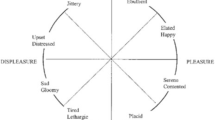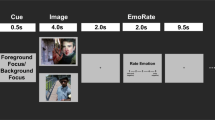Abstract
An experiment was conducted to test Zillmann's hypothesis that misattribution of residual arousal in the excitation transfer paradigm is influenced by the salience of perceived arousal symptoms at the point of potential misattribution. Eighty subjects in a 2×2×2 design were either physiologically aroused or not aroused, and were subsequently subjected to a procedure designed to induce either positive mood (elation) or negative mood (depression). Simultaneously, they were either made self-aware or not. It was reasoned that self-focused attention would lead to heightened awareness of residual arousal and that, if the salience of arousal hypothesis is correct, this would prevent misattribution of arousal and the resultant intensification of experienced emotion from occurring. In accord with this reasoning, it was found that aroused and self-aware subjects experienced residual arousal significantly more intensely, were less prone to misattribute it, and did not show an excitation transfer effect. These results were, however, obtained only for subjects in the negative mood condition.
Similar content being viewed by others
References
Beck, A. T.Cognitive therapy and the emotional disorders. New York: International Universities Press, 1976.
Calvert-Boyanowsky, J., & Leventhal, H. The role of information in attenuating behavioral responses to stress: A reinterpretation of the misattribution phenomenon.Journal of Personality and Social Psychology 1975,32 214–221.
Cantor, J. R., Bryant, J., & Zillmann, D. Enhancement of humor appreciation by transferred excitation.Journal of Personality and Social Psychology 1974,30 812–821.
Cantor, J. R., & Zillmann, D. The effect of affective state and emotional arousal on music appreciation.Journal of General Psychology 1973,89 79–108.
Cantor, J. R., Zillmann, D., & Bryant, J. Enhancement of experienced sexual arousal in response to erotic stimuli through misattribution of unrelated residual excitation.Journal of Personality and Social Psychology 1975,32 69–75.
Carver, C. S. A cybernetic model of self-attention processes.Journal of Personality and Social Psychology 1979,37 1251–1281.
Day, K. D. Short-lived facilitation of aggressive behavior by violent communications.Psychological Reports 1976,38 1068–1070.
Dienstbier, R. A. Emotion-attribution theory: Establishing roots and exploring future perspectives. In R. A. Dienstbier (Ed.),Nebraska Symposium on Motivation. Lincoln: University of Nebraska Press, 1979.
Duncan, O. D.Introduction to structural equation models. New York: Academic Press, 1975.
Duval, S., & Wicklund, R. A.A theory of objective self-awareness. New York: Academic Press, 1972.
Ellis, A. Rational emotive therapy. In A. Burton (Ed.),Operational theories of personality. New York: Brunner/Mazel, 1974.
Gibbons, F. X., Carver, C. S., Scheier, M. F., & Hormuth, S. E. Self-focused attention and the placebo effect: Fooling some people some of the time.Journal of Experimental Social Psychology 1979,15 263–274.
Hampel, R. Adjektiv-Skalen zur Einschaetzung der Stimmung (SES).Diagnostica 1977,23 43–60.
Hoehn-Saric, R., Liberman, B., Imber, S. D., Stone, A. R., Frank, J. D., & Ribich, F. D. Attitude change and attribution of arousal in psychotherapy.Journal of Nervous and Mental Disease 1974, 159, 234–243.
Hull, C. L.Principles of behavior. New York: Appleton-Century-Crofts, 1943.
Kenny, D. A.Correlation and causality. New York: Wiley, 1979.
Kirk, R. E.Experimental design: Procedures for the behavioral sciences. Belmont, California: Brooks/Cole, 1968.
Leventhal, H. Toward a comprehensive theory of emotion. In L. Berkowitz (Ed.),Advances in experimental social psychology (Vol. 13). New York: Academic Press, 1980.
Meichenbaum, D. H.Cognitive-behavioral modification. New York: Plenum Press, 1977.
Nisbett, R. E., & Schachter, S. Cognitive manipulation of pain.Journal of Experimental Social Psychology 1966,2 227–236.
Nisbett, R. E., & Valins, S. Perceiving the causes of one's own behavior. In E. E. Jones, D. E. Kanouse, H. H. Kelley, R. E. Nisbett, S. Valins, & B. Weiner (Eds.),Attribution: Perceiving the causes of behavior. Morristown, New Jersey: General Learning Press, 1972.
Page, M. M. Postexperimental assessment of awareness in attitude conditioning.Educational and Psychological Measurement 1971,31 891–906.
Reisenzein, R.The Schachter theory of emotion: Two decades later. Manuscript submitted for publication, 1982.
Rodin, J. Menstruation, reattribution, and competence.Journal of Personality and Social Psychology 1976,33 345–353.
Ross, L., Rodin, J., & Zimbardo, P. H. Toward an attribution therapy: The reduction of fear through induced cognitive-emotional misattribution.Journal of Personality and Social Psychology 1969,12 279–288.
Schachter, S. The interaction of cognitive and physiological determinants of emotional state. In L. Berkowitz (Ed.),Advances in experimental social psychology (Vol. 1). New York: Academic Press, 1964.
Schachter, S., & Singer, J. Cognitive, social, and physiological determinants of emotional state.Psychological Review 1962,69 379–399.
Scheier, M. F. Self-awareness, self-consciousness, and angry aggression.Journal of Personality 1976,44 627–644.
Scheier, M. F., & Carver C. S. Self-focused attention and the experience of emotion: Attraction, repulsion, elation, and depression.Journal of Personality and Social Psychology 1977,37 625–636.
Scheier, M. F., Carver, C. S., & Gibbons, F. X. Self-directed attention, awareness of bodily states, and suggestibility.Journal of Personality and Social Psychology 1979,37 1576–1588.
Spence, K. W.Behavior theory and conditioning. New Haven: Yale University Press, 1956.
Tannenbaum, P. H., & Zillmann, D. Emotional arousal in the facilitation of aggression through communication. In L. Berkowitz (Ed.),Advances in experimental social psychology (Vol. 8). New York: Academic Press, 1975.
White, G. L., Fishbein, S., & Rutstein, J. Passionate love and the misattribution of arousal.Journal of Personality and Social Psychology 1981,41 56–62.
Velten, E. A laboratory task for induction of mood states.Behaviour Research and Therapy 1968,6 473–482.
Zillmann, D. Excitation transfer in communication-mediated aggressive behavior.Journal of Experimental Social Psychology 1971,7 419–434.
Zillmann, D. Attribution and misattribution of excitatory reactions. In J. H. Harvey, W. J. Ickes, & R. F. Kidd (Eds.),New directions in attribution research (Vol. 2). Hillsdale, New Jersey: Erlbaum, 1978.
Zillmann, D., & Bryant, J. Effect of residual excitation on the emotional response to provocation and delayed aggressive behavior.Journal of Personality and Social Psychology 1974,30 782–791.
Zillmann, D., Johnson, R. C., & Day, K. D. Attribution of apparent arousal and proficiency of recovery from sympathetic activation affecting excitation transfer to aggressive behavior.Journal of Experimental Social Psychology 1974,10 503–515.
Zillmann, D., Katcher, A. H., & Milavsky, B. Excitation transfer from physical exercise to subsequent aggressive behavior.Journal of Experimental Social Psychology 1972,8 247–259.
Zillmann, D., Mody, B., & Cantor, J. R. Empathic perception of emotional displays in films as a function of hedonic and excitatory state prior to exposure.Journal of Research in Personality 1974,8 335–349.
Author information
Authors and Affiliations
Additional information
This paper was written while the first author was a Visiting Fulbright scholar at the University of California, Los Angeles. The authors would like to thank Bernard Weiner for his helpful comments on an earlier draft of the manuscript.
Rights and permissions
About this article
Cite this article
Reisenzein, R., Gattinger, E. Salience of arousal as a mediator of misattribution of transferred excitation. Motiv Emot 6, 315–328 (1982). https://doi.org/10.1007/BF00998188
Issue Date:
DOI: https://doi.org/10.1007/BF00998188




